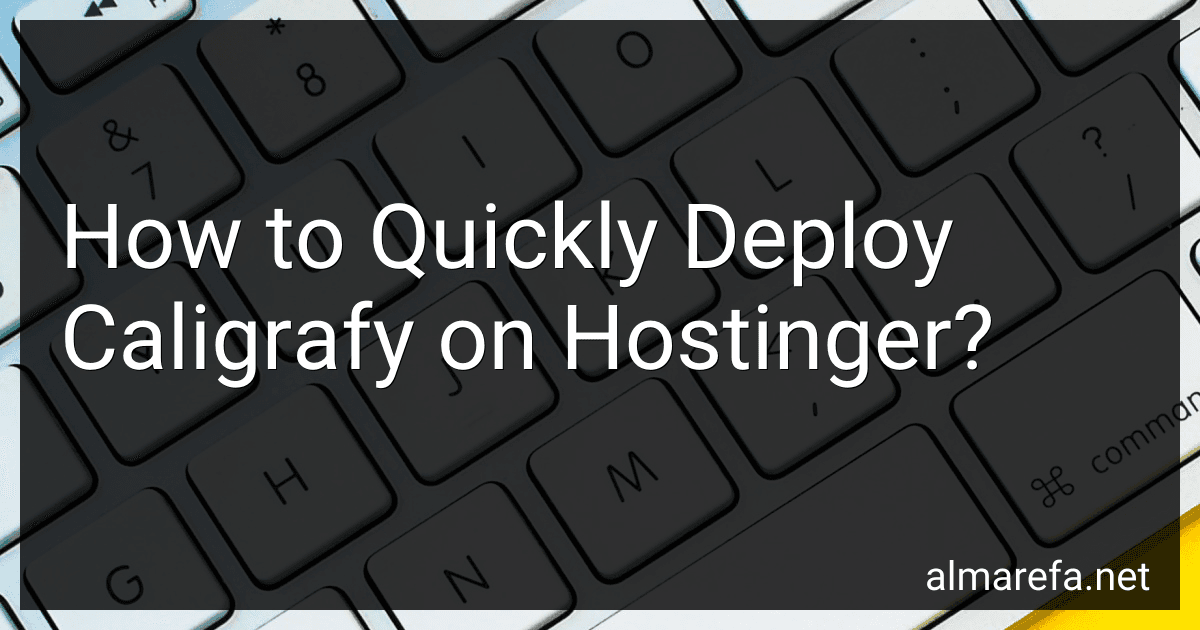Posts (page 50)
-
 8 min readTo generate HTML documentation in Go, you can use the built-in go doc command or external tools such as godoc and golint. Here is a brief explanation of how you can generate HTML documentation in Go:go doc: Go provides a built-in tool called go doc that can generate HTML documentation for Go packages and symbols.
8 min readTo generate HTML documentation in Go, you can use the built-in go doc command or external tools such as godoc and golint. Here is a brief explanation of how you can generate HTML documentation in Go:go doc: Go provides a built-in tool called go doc that can generate HTML documentation for Go packages and symbols.
-
 12 min readTo deploy CodeIgniter on DigitalOcean, you can follow these steps:Create a DigitalOcean Droplet: Start by creating a Droplet (virtual machine) on DigitalOcean. Choose the desired specifications and operating system (Ubuntu, CentOS, etc.) for your Droplet. Access the Droplet: Once the Droplet is created, access it via SSH using a tool like PuTTY (for Windows) or the built-in Terminal (for macOS/Linux). Use the provided IP address and login credentials to connect.
12 min readTo deploy CodeIgniter on DigitalOcean, you can follow these steps:Create a DigitalOcean Droplet: Start by creating a Droplet (virtual machine) on DigitalOcean. Choose the desired specifications and operating system (Ubuntu, CentOS, etc.) for your Droplet. Access the Droplet: Once the Droplet is created, access it via SSH using a tool like PuTTY (for Windows) or the built-in Terminal (for macOS/Linux). Use the provided IP address and login credentials to connect.
-
 8 min readTo open a file with a specific encoding in Golang, you can follow these steps:Import the necessary packages: import ( "golang.org/x/text/encoding" "golang.org/x/text/encoding/charmap" "io/ioutil" "os" ) Define a function to open the file with the desired encoding: func OpenFileWithEncoding(filename string, enc encoding.Encoding) ([]byte, error) { // Open the file file, err := os.Open(filename) if err .
8 min readTo open a file with a specific encoding in Golang, you can follow these steps:Import the necessary packages: import ( "golang.org/x/text/encoding" "golang.org/x/text/encoding/charmap" "io/ioutil" "os" ) Define a function to open the file with the desired encoding: func OpenFileWithEncoding(filename string, enc encoding.Encoding) ([]byte, error) { // Open the file file, err := os.Open(filename) if err .
-
 6 min readTo execute terminal commands from Golang, you can use the os/exec package which allows executing system commands. Here is a simple approach to achieving this:Import the necessary package: import "os/exec" Use the Command function from os/exec to create a new Cmd struct: cmd := exec.Command("command_name", "arg1", "arg2", ...) Replace "command_name" with the name of the command you want to execute and "arg1", "arg2", etc.
6 min readTo execute terminal commands from Golang, you can use the os/exec package which allows executing system commands. Here is a simple approach to achieving this:Import the necessary package: import "os/exec" Use the Command function from os/exec to create a new Cmd struct: cmd := exec.Command("command_name", "arg1", "arg2", ...) Replace "command_name" with the name of the command you want to execute and "arg1", "arg2", etc.
-
 6 min readTo deploy Gatsby on Linode, you can follow these steps:Create a Linode account and log in to the Linode Cloud Manager. Create a Linode instance by clicking on the "Create" button and selecting the desired plan and region. Choose the Linux distribution of your choice. Once the Linode instance is created, note down the IP address and SSH into your Linode machine using your preferred SSH client.
6 min readTo deploy Gatsby on Linode, you can follow these steps:Create a Linode account and log in to the Linode Cloud Manager. Create a Linode instance by clicking on the "Create" button and selecting the desired plan and region. Choose the Linux distribution of your choice. Once the Linode instance is created, note down the IP address and SSH into your Linode machine using your preferred SSH client.
-
 6 min readTo convert strings to lowercase in Go, you can make use of the strings package and specifically the ToLower function. Here's an example of how you can achieve this: package main import ( "fmt" "strings" ) func main() { str := "Hello World!" lowercaseStr := strings.ToLower(str) fmt.Println(lowercaseStr) } In the above code, we import the necessary packages: fmt for printing the output, and strings for accessing the ToLower function.
6 min readTo convert strings to lowercase in Go, you can make use of the strings package and specifically the ToLower function. Here's an example of how you can achieve this: package main import ( "fmt" "strings" ) func main() { str := "Hello World!" lowercaseStr := strings.ToLower(str) fmt.Println(lowercaseStr) } In the above code, we import the necessary packages: fmt for printing the output, and strings for accessing the ToLower function.
-
 8 min readTo quickly deploy Caligrafy on Hostinger, you can follow the steps below:Access your Hostinger account and log in.Go to the control panel or dashboard of your Hostinger hosting.Look for the "Website" or "Websites" section and click on it.Select the domain or subdomain where you want to deploy Caligrafy.Choose the option to install a new application or script.In the search bar, type "Caligrafy" and select it from the search results.
8 min readTo quickly deploy Caligrafy on Hostinger, you can follow the steps below:Access your Hostinger account and log in.Go to the control panel or dashboard of your Hostinger hosting.Look for the "Website" or "Websites" section and click on it.Select the domain or subdomain where you want to deploy Caligrafy.Choose the option to install a new application or script.In the search bar, type "Caligrafy" and select it from the search results.
-
 5 min readTo print a 2-dimensional array as a grid in Golang, you can use nested loops to iterate over the elements of the array and output them in a formatted manner. Here's an example code snippet to accomplish this: package main import "fmt" func printGrid(arr [][]int) { rows := len(arr) cols := len(arr[0]) // Iterate over each element of the array for i := 0; i < rows; i++ { for j := 0; j < cols; j++ { fmt.
5 min readTo print a 2-dimensional array as a grid in Golang, you can use nested loops to iterate over the elements of the array and output them in a formatted manner. Here's an example code snippet to accomplish this: package main import "fmt" func printGrid(arr [][]int) { rows := len(arr) cols := len(arr[0]) // Iterate over each element of the array for i := 0; i < rows; i++ { for j := 0; j < cols; j++ { fmt.
-
 4 min readTo find emojis from strings using Golang, you can follow these steps:Import the necessary packages: import ( "fmt" "regexp" ) Define a regular expression to match emojis.
4 min readTo find emojis from strings using Golang, you can follow these steps:Import the necessary packages: import ( "fmt" "regexp" ) Define a regular expression to match emojis.
-
 7 min readSymfony can be deployed on a variety of platforms, including:Web servers such as Apache or NginxCloud-based platforms like AWS (Amazon Web Services), Google Cloud, and Microsoft AzurePlatform-as-a-Service (PaaS) providers like Heroku or Platform.shDocker containersShared hosting environmentsOn-premises serversThe flexibility of Symfony allows it to be deployed on virtually any platform or server setup that supports PHP and meets the system requirements.
7 min readSymfony can be deployed on a variety of platforms, including:Web servers such as Apache or NginxCloud-based platforms like AWS (Amazon Web Services), Google Cloud, and Microsoft AzurePlatform-as-a-Service (PaaS) providers like Heroku or Platform.shDocker containersShared hosting environmentsOn-premises serversThe flexibility of Symfony allows it to be deployed on virtually any platform or server setup that supports PHP and meets the system requirements.
-
 10 min readTo mock SQL queries in Golang, you can follow these steps:Use an interface: Define an interface that represents your database connection and query methods. For example, you can have an interface named Database with methods like Query, Exec, and Prepare. Create a mock implementation: Write a mock implementation of the Database interface. This implementation will replace the actual interaction with the database.
10 min readTo mock SQL queries in Golang, you can follow these steps:Use an interface: Define an interface that represents your database connection and query methods. For example, you can have an interface named Database with methods like Query, Exec, and Prepare. Create a mock implementation: Write a mock implementation of the Database interface. This implementation will replace the actual interaction with the database.
-
 9 min readIn order to implement thread-safe maps in Golang, you can follow the principles of concurrent programming and leverage the sync package provided by the standard library.Start by importing the sync package: import "sync" Create a new type that wraps a regular map and includes a mutex to ensure safe concurrent access: type SafeMap struct { m map[string]interface{} mtx sync.
9 min readIn order to implement thread-safe maps in Golang, you can follow the principles of concurrent programming and leverage the sync package provided by the standard library.Start by importing the sync package: import "sync" Create a new type that wraps a regular map and includes a mutex to ensure safe concurrent access: type SafeMap struct { m map[string]interface{} mtx sync.